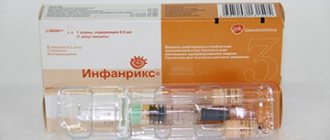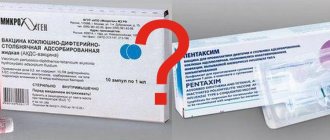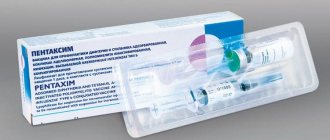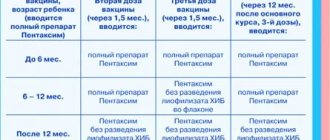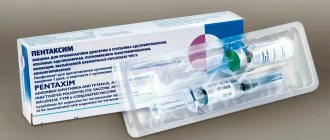Infanrix Hexa and Pentaxim are combination vaccines that are used for the purpose of routine prevention of severe diseases affecting the digestive, cardiovascular, respiratory and central nervous systems.
These medications are approved for use in newborns over 2 months of age. The Infanrix Hexa or Pentaxim vaccines can be used by pediatricians, therapists and infectious disease specialists to immunize the population during epidemiological outbreaks of infectious diseases.
Comparative characteristics of the drugs Infanrix Hexa and Pentaxim. Commonality and differences
Vaccines with a complex biochemical composition Infanrix Hexa and Pentaxim have more common properties than distinctive features. These drugs are used to prevent morbidity in children and adult patients from the same types of diseases, and also have an almost identical list of constituent components.
The main difference between these drugs is that Infanrix Hexa is a Belgian-made vaccine, and Pentaxim is produced by a French pharmaceutical company. Also, the lyophilisate of the latter medicine does not contain hepatitis B virions.
Compound
Infanrix Hexa, Pentaxim or other combination vaccine intended for artificial immunization of the population always contains more than 2 active components.
The main components of 0.5 ml of the drug Infanrix Hexa are the following biochemical compounds:
- adsorbed toxoid T of the causative agent of tetanus - is within 40 IU;
- adsorbed toxoid D of the infectious agent diphtheria - 30 IU;
- adsorbed pertussis toxoid RT - 25 mcg;
- filamentous hemagglutinin - 25 mcg;
- adsorbed pertactin - 8 mcg;
- r-DNA of the surface virus, which is the causative agent of hepatitis B - no more than 10 μg;
- poliovirus type 1 virions - at least 40 units;
- poliovirus type 2 virions - 8 units;
- poliovirus type 3 virions - within 32 units;
- strain of the causative agent of Haemophilus influenzae type B - 10 mcg.
The Infanrix Hexa vaccine also includes a complex of excipients in the form of sodium chloride, sterile water for injection, on the basis of which a suspension is prepared, aluminum salts, polysorbate, glycine, polymyxin B sulfate, neomycin, and potassium phosphate.
Externally, this vaccine is a free-flowing white powder. The Infanrix Hexa vaccine comes with a disposable syringe and 0.5 ml of water for injection.
The multicomponent vaccine Pentaxim contains the following active substances:
- adsorbed toxoid D of the causative agent of diphtheria - 30 IU;
- adsorbed tetanus toxoid T - is within 40 IU;
- adsorbed RT toxoid of the causative agent of whooping cough - 25 mcg;
- filamentous hemagglutinin - 25 mcg;
- poliovirus type 1 virions - at least 40 units;
- poliovirus type 2 virions - 8 units;
- poliovirus type 3 virions - within 32 units;
- strain of the causative agent of Haemophilus influenzae type B - 10 mcg.

The excipients of this drug are aluminum salts, formaldehyde, sucrose, sterile water for injection, trometamol, phenoxyethanol, acetic acid.
Compared to the Infanrix Hexa vaccine, Pentaxim only lacks r-DNA of the surface virus, which is the causative agent of hepatitis B. Infection with this microorganism leads to damage to liver tissue.
Pharmacological properties
Infanrix Hexa or Pentaxim are used by pediatricians, therapists and infectious disease specialists to prevent epidemiological outbreaks of viral and bacterial diseases.
Due to the presence of an identical biochemical composition, these drugs have the same pharmacological properties in the form of artificial stimulation of the development of one’s own immunity against pathogens of infectious diseases.
The multicomponent vaccines Infanrix Hexa and Pentaxim make it possible to achieve the synthesis of seroprotective antibodies against each antigen included in their composition. The pharmacological effectiveness of these drugs is 98.4%, which makes it possible to achieve high rates of immunization of the population, as well as prevent epidemiological outbreaks of particularly dangerous infections.
Indications
The combined vaccines Pentaxim and Infanrix Hexa are indicated for use for the purpose of planned or emergency prevention of the following diseases of viral and bacterial origin:
- tetanus;
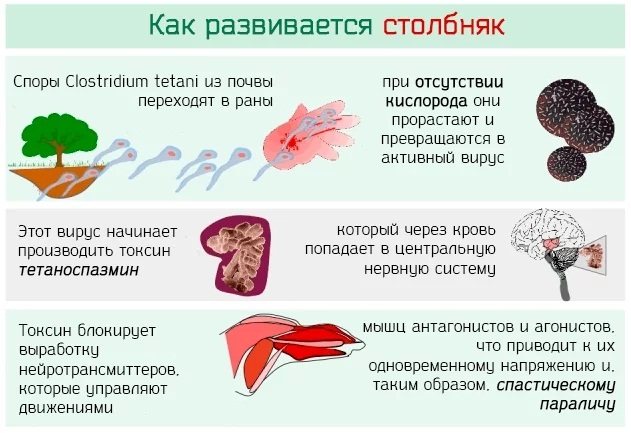
Infanrix Hexa or Pentaxim - both tetanus shots - polio;
- whooping cough;
- diphtheria;
- hemophilus influenzae infection;
- Hepatitis B.
You should also take into account the fact that Pentaxim is not used to prevent severe liver disease caused by the hepatitis B virus, since the r-DNA of this microorganism contains only the drug Infanrix Hexa.
To achieve a positive effect of immunization against the above diseases, it is necessary to undergo routine vaccination in accordance with the vaccination schedule. The use of these drugs is indicated for newborn children over 2 months of age who do not yet have strong immunity, as well as for adults who require revaccination.
Comparison of Infanrix and Pentaxim vaccines: what is the difference?
As analogues of the domestic vaccination drug DPT, imported vaccines Infanrix or Pentaxim are often used. They provide immune protection against such dangerous and severe infectious diseases as whooping cough, diphtheria and tetanus.
In order to determine which vaccine is actually better, safer and more effective, you should familiarize yourself in detail with the composition, properties and principle of action of each.
Differences in composition
The drug Infanrix, manufactured by the UK pharmaceutical company GlaxoSmithKline, contains the following set of main components:

- tetanus toxoid (40 IU);
- diphtheria toxoid (30 IU);
- purified pertussis antigens (25 μg).
Added as excipients:
- water for injections;
- aluminum hydroxide and phosphate;
- sodium chloride;
- polysorbate;
- 2-phenoxyethanol;
- formaldehyde.
The Pentaxim vaccine is produced by the French pharmaceutical company Sanofi Pasteur. This drug protects not only against whooping cough, tetanus and diphtheria, but also against three types of polio.
The main active ingredients are:

- pertussis toxoid (25 mcg);
- diphtheria toxoid (40 IU);
- tetanus toxoid (30 IU);
- inactivated polio viruses (types 1, 2 and 3);
- filamentous hemagglutinin.
In addition, the Pentaxim vaccine contains auxiliary components:
- aluminum hydroxide;
- phenoxyethanol;
- sodium chloride or acetic acid;
- formaldehyde;
- Hanks medium;
- purified water for injection.
The difference in auxiliary components, stabilizers and fillers in the composition of vaccines is especially important in cases where allergic reactions to certain substances occur.
Are there differences in timing of vaccinations?
Both of the vaccines under consideration are used after the baby reaches three months of age and require three administrations.
The drug Infanrix is used according to the following schedule:
- first vaccination - at 3 months;
- the second - at 4.5 months;
- the third - at 6 months.
An interval of at least 1.5 months must be maintained between vaccinations. After this, at the age of 18 months, a second vaccination is given. This injection method is designed to provide almost one hundred percent protection against whooping cough, diphtheria and tetanus.
The Pentaxim vaccine, according to the instructions, is administered according to a similar scheme.
The first time is at 3 months, and the next two after 1.5 or 2 months. Revaccination is carried out after the baby turns one and a half years old.
In case of violation of the standard vaccination schedule, the drug is used according to the following scheme:
- the first and second vaccinations should be given between 6 and 12 months of age using the usual method;
- the third vaccination must be performed with a suspension without lyophilisate.
If the first vaccination is carried out over the age of one year, for it and the next two, only a suspension without lyophilisate is used.
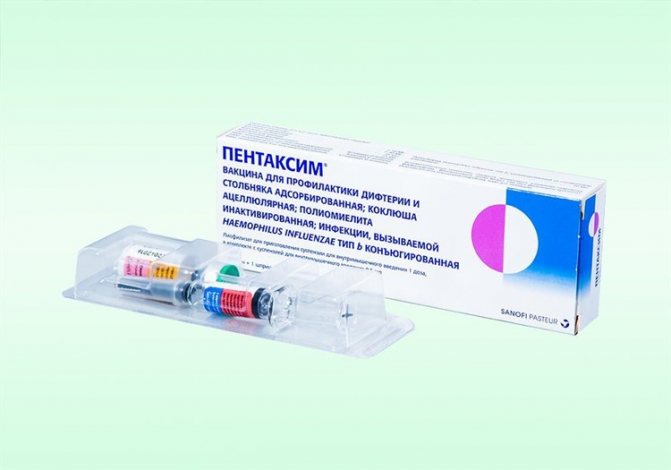
Vaccine Pentaxim
Do they differ in price?
The average cost of the Infanrix vaccine is 2000-2300 rubles per package. Pentaxim can be purchased a little cheaper - from 1200 to 1700 rubles.
Contraindications
Infanrix Hexa or Pentaxim are used routinely to preserve the health of the general population, or in emergency cases to eliminate an epidemiological outbreak of increased incidence of the above ailments.
At the same time, these vaccines are strictly contraindicated for administration to patients who have the following body diseases:
- the patient has a history of progressive encephalopathy, which is accompanied by convulsions of the lower extremities, or occurs without such symptoms;
- hypotonic or hyporesponsive syndrome, which is observed in newborns;
- the individual tendency of the body to exhibit various types of allergic reactions that previously occurred after the administration of vaccines with a similar biochemical composition (the patient may have intolerance to diphtheria, pertussis, tetanus toxoid or other components of the drug);
- increased body temperature caused by an acute inflammatory process;
- exacerbation of chronic diseases, or the presence of a focus of bacterial, viral or fungal infection (in this case, routine vaccination is postponed to a later date until complete recovery and strengthening of the protective functions of the immune system);
- increased hypersensitivity to streptomycin, glutaraldehyde, polymyxin B, and neomycin.
The Infanrix Hexa and Pentaxim vaccines contain weakened or dead strains of viral and bacterial microorganisms. The introduction of these biological agents into the human body does not cause the development of an acute infectious process, but only under the condition of normal functioning of the immune system.
Patients suffering from immunodeficiency conditions are advised to refrain from using vaccines until they feel completely normal. Infanrix Hexa and Pentaxim are prescribed with extreme caution to children with a history of febrile seizures.
Instructions for use
Infanrix Hexa or Pentaxim should be used according to the instructions for use of these drugs. A preventive course of immunization of the body with multicomponent vaccines consists of 3 injections, each dose containing 0.5 ml of active substances, which are carried out according to the developed schedule.
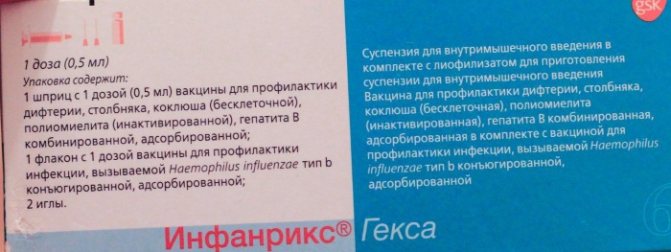
A preventive vaccination plan is developed individually for each patient. Infanrix Hexa and Pentaxim are injected into the upper part of the outer thigh. These drugs are intended exclusively for intramuscular injections. It is strictly forbidden to vaccinate with these medications subcutaneously or intravenously.
A needle with a syringe containing the active components of Pentaxim or Infanrix Hexa is inserted as deeply as possible. In this case, it is necessary to ensure that the injection is not performed into a blood vessel. The vaccine is prepared by mixing the powdered lyophilisate with sterile water, which comes with the drug.
After the powder has completely dissolved, the medicine is ready for use. The vaccine should be white with signs of turbidity. If, after dissolving the lyophilisate, the liquid preparation acquires other color shades, then you should refrain from using this medication.
The finished vaccine is drawn into a disposable sterile syringe and then injected intramuscularly into the patient’s body. Injection of the contents of the drug should be carried out as slowly as possible.
Upon completion of routine vaccination, the patient should monitor his body temperature and general well-being over the next 48 hours, especially if immunization was carried out on a newborn child. The table below shows the planned vaccination schedule for children at different periods of their development.
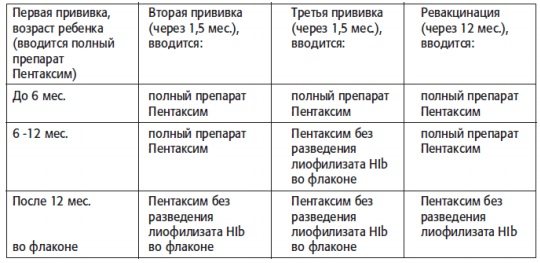
| Vaccination course with Infanrix Hexa or Pentaxim | Age of the child who is subject to routine immunization |
| 1st vaccination | For 3 months throughout his life, a newborn child must receive an intramuscular injection of the multicomponent vaccine Pentaxim or Infanrix Hexa. The selection of the drug is carried out by a pediatrician who is registered with the patient. The primary dosage of these drugs is 0.5 ml, and in case of urgent need, immunization of the body is allowed when the child reaches 2 months. |
| 2nd vaccination | The second vaccination should be carried out when the child reaches the age of 4.5 months. An intramuscular injection in a dosage of 0.5 ml is performed in a children's clinic at the place of registration of the patient on a first-come, first-served basis. At the same time, the doctor monitors that no more than 1.5 months have passed from the moment of 1 vaccination. |
| 3rd vaccination | The third stage of immunization of the child’s body occurs after the child turns 6 months old. This is the final stage of the production of antibodies against antigens that were administered along with medications. |
| Revaccination | Repeated revaccination should be carried out after 18 months. after the 3rd vaccination. This will consolidate the results obtained, providing the child with reliable immune protection against dangerous childhood diseases of infectious origin. Revaccination can be performed for children under 4 years of age. |
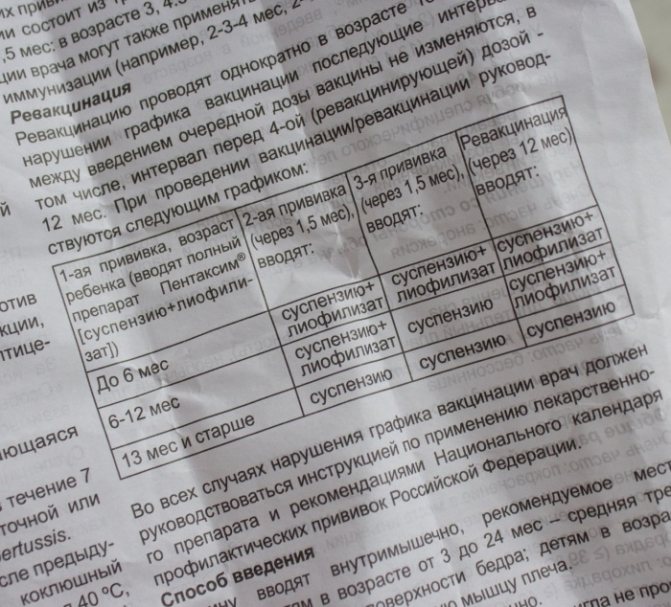
In all cases, without exception, the schedule for artificial immunization of patients is drawn up by a pediatrician, therapist or infectious disease specialist, whose responsibilities include monitoring the routine vaccination of patients.
Timely use of Infanrix Hexa or Pentaxim helps preserve the health of the child and the adults around him. This approach will prevent the development of severe infectious diseases.
Vaccination schedules
The Infanrix vaccine is administered in three stages:
- at three months;
- at 4.5 months;
- in six months.
The intervals must be strictly observed and are exactly 1.5 months. After this, mandatory revaccination should be carried out at 18 months. If you follow all the rules and do the vaccination correctly, this gives an almost 100% guarantee of protection against infectious diseases.
Pentaxim also begins to be used at 3 months. The next vaccine administration should be in 1-2 months. Like the previous vaccination, Pentaxim requires repeated revaccination at 1.5 years. If the schedule for using the Pentaxim vaccine is violated, it can be used according to the following scheme:
- Between 6 and 12 months, the first and second vaccinations. And the third vaccine is administered without the use of lyophilisate. And revaccination is done with a full preparation;
- If the child is more than one year old, the first vaccine is given with the full preparation, and all further vaccinations are given without using protection against Haemophilus influenzae.
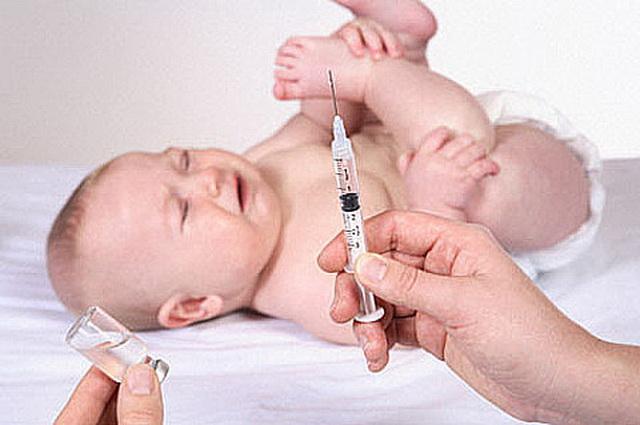
Doctors do not recommend using two vaccines at the same time; there is no need to replace them. It is better to stick to a specific schedule and use only one of the suggested drugs. If there is a forced replacement of drugs for vaccination, you should consult a doctor and carry out vaccination strictly under supervision.
Important! It is very important that the attending physician himself prescribes a specific drug, based on the individual characteristics of the child. Choosing one or another type of vaccine yourself is strictly contraindicated, as this can cause serious complications.
Possible side effects
And although the vaccines are similar in composition, they have differences that can cause side effects. When choosing a vaccine, you should carefully study not only the components, but also the reactions that may occur after the injection.
After many studies, doctors came to the conclusion that the Pentaxim vaccine causes side effects in only 5%, which is slightly less than Infanrix. It is necessary to consider in more detail each of the above drugs. Side effects from using Infanrix:
- repeated administration may cause febrile symptoms;
- there may be swelling and slight swelling at the site where the injection was given;
- slight nervousness;
- pain and nausea;
- body temperature and enlarged lymph nodes;
- there is a feeling of lack of oxygen;
- on the body (urticaria), as well as redness, peeling of the skin and itching;
- breathing.
Popular Instantly saving a person with serum after a viper bite
Side effects from using Pentaxim:
- there is pain at the injection site, especially when pressed lightly;
- and slight swelling at the injection site;
- irritability (excessive crying and sleep disturbance);
- headaches, nausea, fever;
- cough;
- bluish tint on mucous membranes.

DTP imported vaccine Pentaxim or Infanrix can cause a number of other side effects. This may be influenced by the body's individual response to the vaccine. There have been cases when a baby died after administration of the drug. But such cases are isolated and arose due to the doctor’s oversight.
Contraindications for the use of vaccinations
There are some contraindications for the use of vaccinations. For the drug Infanrix there are such contraindications as: encephalopathy, anemia and the presence of coagulopathy in newborns weighing less than 2 kg.
Contraindications for Pentaxim: intolerance to substances in the vaccine, incipient inflammation of the brain, fever and any other respiratory infection. In general, doctors recommend not using vaccinations for colds, because there is a risk of complications or side effects. It is better to get vaccinated a few days after recovery. Accordingly, the doctor must conduct an examination and do the necessary tests and decide on vaccination.
Compliance with the rules
To avoid complications or side effects, you should follow some rules:
- It is forbidden to vaccinate a sick baby;
- If a child is unwell or suspects a cold, do not hide it from the doctor;
- Before vaccination, it is necessary to cleanse the baby’s intestines;
- Before vaccination, you should not overfeed your child;
- After the injection, give the baby a good drink and avoid hypothermia;
- After vaccination, do not give new foods or those that can cause an allergic reaction for several days;
- It is not recommended to visit rooms with large crowds of people in the first days after the injection;
- If a fever occurs, it is worth giving the child a means to lower the temperature. Any drug must be prescribed by the attending physician.
A separate point is that before the procedure, it is important to carefully inspect the packaging of the drug, make sure it is intact and look in detail at the expiration date. If you have any doubts or the vaccine package was deformed, you should replace the drug.
After vaccination, you need to make sure that all data is recorded in the baby’s card; this is necessary for maintaining a calendar, reactions to vaccination and recording possible side effects. Entries in the journal serve as a certain insurance for both the doctor and the baby’s parents.
Prices for Pentaxim or Infanrix
When choosing a vaccination, an important point is not only the quality of the medicine, but also its price. For some families, the question of the cost of the drug becomes decisive. Average cost of drugs:
- Pentaxim is a little more expensive, costs 1300-1500 rubles
- Infanrix costs about 750-800 rubles
Doctors still have different opinions about which vaccine is better, domestic or imported, Pentaxim or Infanrix. And although the drugs have many disadvantages, they are considered effective. Despite the side effects and a large number of contraindications, doctors talk about the need and importance of vaccinations. If a child does not have immunity to certain diseases, this can cause death or severe illness.
Application in special cases
Infanrix Hexa or Pentaxim are used in special cases when there is a massive outbreak of diphtheria, whooping cough, tetanus, polio, and hemophilus influenzae.
An unfavorable epidemiological situation may develop in regions where the immunization schedule for children under 4 years of age is regularly disrupted and a large number of unvaccinated people live.
If these circumstances exist, measures are taken to urgently vaccinate the general population. First of all, newborn children receive intramuscular injections of multicomponent vaccines, and only then older patients.
Scheme and method of administration of the Infanrix Hexa vaccine
The vaccine is injected deeply intramuscularly into the middle third of the front surface of the child's thigh. Infanrix Hexa is prescribed as a three-dose primary vaccination in children under 6 months of age. The same dose of the vaccine is administered three times with an interval of 45 days:
at 4.5 – 6 months (recommended by the National Calendar);
Side effects
The multicomponent vaccines Pentaxim and Infanrix Hexa are well tolerated by most newborns and older patients. According to the results of laboratory studies that took place at the stage of clinical testing, the constituent components of these drugs can cause the development of the following side effects:
- manifestation of a local allergic reaction in the form of redness and swelling of epithelial tissues in the area of injection of Infanrix Hexa or Pentaxim;
- an increase in body temperature, which is kept between 37 and 38 degrees Celsius (a more serious violation of thermoregulation, requiring the use of antipyretics, cannot be ruled out);
- fever, chills and increased sweating;
- progressive lymphadenopathy;
- attacks of severe headache;
- insomnia and other signs of sleep disturbance (prolonged period of falling asleep, nightmares, frequent waking up);
- a feeling of itching and the presence of tissue compaction in the area of injection of the vaccine (this is a serious side effect that requires going to the hospital, since there is a high probability of further development of the inflammatory process);
- increased irritability and mood swings.
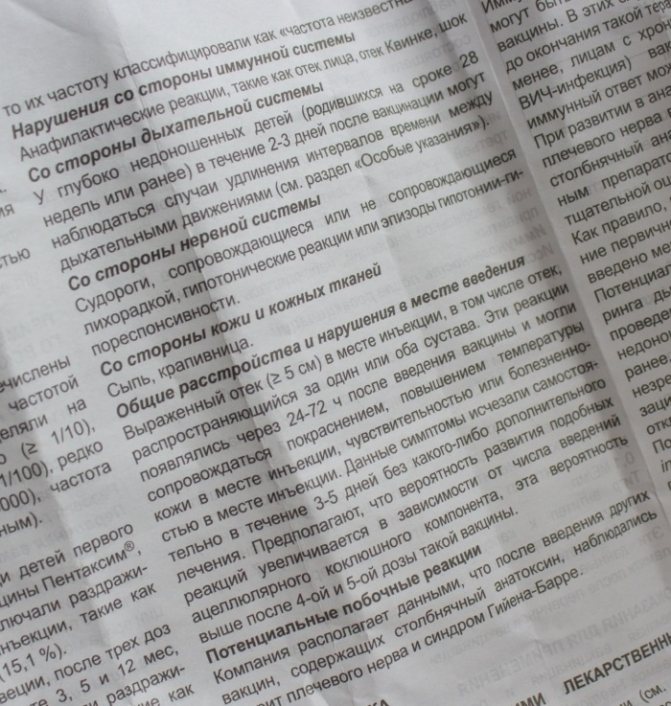
A positive feature of the combined vaccines Pentaxim and Infanrix Hexa is that they do not cause severe allergic reactions in the form of bronchial spasm or angioedema.
Most of the above side effects persist for 1-3 days after injection of these drugs. After the completion of the immunization period, the child’s well-being returns to normal.
Pentaxim or Infanrix: which is better to choose?
Both foreign vaccines described are multicomponent safe preparations that use substances approved for children. When choosing, they are guided by the planned vaccination schedule, the presence of contraindications and the age of the baby.
Parents should remember that imported medicines for pertussis-diphtheria-tetanus immunization are more expensive than domestic analogues. Russian vaccines, in the absence of contraindications for the baby, are not inferior in effectiveness, but at the same time they cost less, although the adverse reactions are more pronounced.
Prices for Pentaxim and Infanrix
The average price of Pentaquim in pharmacies is 1300-1500 rubles, the British-made drug Infanrix Hexa costs less - 750-800 rubles per package. The total cost of vaccination is determined by multiplying the price by the number of injections provided for in the vaccination schedule.
Compatibility with other medications, with alcohol
During the period of vaccination with Pentaxim or Infanrix Hexa, it is not recommended to take medications that affect the functions of cells of the immune system. Immunosuppressants are completely prohibited, since in this case the effect of immunizing the child will not be achieved, or severe side effects will develop.
The pediatrician who prescribed routine vaccination should be promptly informed about all medications that the patient is taking. The responsibility to provide this information falls on the parents and guardians of a young child.
The multicomponent vaccines Infanrix Hexa and Pentaxim can be administered on the same day as other vaccinations, but not with the BCG immunization complex. However, all other injections should be done in different parts of the body. For example, in the other outer part of the thigh or in the muscles of the forearm.
This will allow you to evenly distribute the immune load with drugs from this group, and also minimize the risk of side effects. The drugs Infanrix Hexa and Pentaxim are completely interchangeable.
With the help of these medications, it is possible to complete a multi-stage vaccination initiated by other means of immunization against whooping cough, diphtheria, polio, Haemophilus influenzae, hepatitis B, and tetanus. Laboratory studies on the compatibility of vaccines with alcohol have not been conducted.
Infanrix Hexa or Pentaxim - which is better?
Infanrix Hexa and Pentaxim are multicomponent vaccines that have virtually no differences between their pharmacological properties and biochemical composition.
For children
When choosing an immunizing vaccine for newborn infants and older children under 4 years of age, it is recommended to pay attention to a drug with a broader spectrum of action. In this case, it is Infanrix Hexa.

This medicine allows you to vaccinate a young child not only against whooping cough, Haemophilus influenzae, diphtheria, polio, tetanus, but also protect him from infection with hepatitis B. When using the Pentaxim vaccine, there will remain a risk of infection with this viral disease, which can lead to severe disruptions in work liver.
For nursing and pregnant women
The drugs Pentaxim, Infanrix Hexa, as well as other combination vaccines with a similar biochemical composition are not used for pregnant women, as well as those lactating a newborn baby with breast milk.
For adults
Medicines Infanrix Hexa and Pentaxim are intended for artificial immunization of children over 2 months of age. up to 4 years. These drugs are not used for adult patients.
Specifics of the Pentaxim vaccine
A medicine with a wide spectrum of action, which contains many additional components, can protect not only from standard infections: tetanus, diphtheria and whooping cough, but also from three different types of polio. This vaccine can be given to babies starting from three months. Pentaxim consists of the following components:
- diphtheria, tetanus, whooping cough;
- hemagglutinin;
- or non-live types of polio virus.
Additional substances contained in the drug: aluminum hydroxide, Hanks' medium, phenoxyethanol, water for injection, sodium chloride. Using the lyophilisate that is part of the drug, the vaccine can protect against various diseases caused by Haemophilus influenzae.
The French-made Pentaxim vaccine itself is considered an improved version of the Infanrix vaccine. But it contains many stabilizers and fillers, which are important for those who have a reaction to one of the components of the drug.
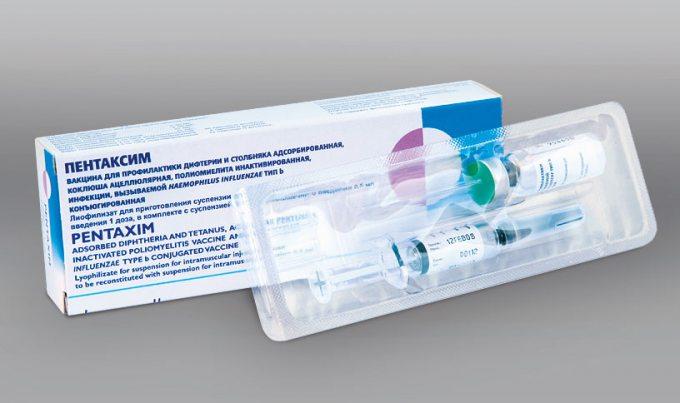
It is very difficult to say which is better Pentaxim or Infanrix, considering only the composition of the drugs. Here it is necessary to analyze it in complex, taking into account the specifics of the drug, its components, compatibility with other drugs, and the likelihood of adverse reactions.
What do vaccines protect against?
The main purpose of the drugs Pentaxim and Infanrix is protection against various infectious diseases. You can use drugs for the purpose of prevention against the following diseases:
- First of all, it is diphtheria. An infectious disease of the upper respiratory tract that affects the pharynx, bronchi and larynx. Very often the disease causes complications on the cardiac system and affects the central nervous system. May cause death.
- Tetanus is also an infectious disease that can cause complications in the form of: pneumonia, severe bronchitis, pulmonary edema. Death is also possible.
- Whooping cough. A disease characterized by a prolonged spasmodic cough. The disease can cause pneumonia, convulsions, and shortness of breath.
- The drugs can be used to prevent polio, because this disease also has serious consequences, such as paralysis.
- Vaccines are also used to prevent diseases caused by Haemophilus influenzae. Manifestations of which: pneumonia, inflammation of the lining of the brain, infection of the blood and internal organs.
Popular The effectiveness and meaning of diphtheria vaccination for adults
Is it possible to replace a familiar vaccine with an imported one? Which DTP vaccine is better, domestic or imported? In many ways, the choice also depends on the price, because imported vaccines are much more expensive and few parents can afford them. But here it is important to choose a high-quality drug, the trust in which is confirmed by many years of use and positive reviews from doctors and parents.
What are the features of such popular vaccines?
- Vaccines contain only high-quality, well-purified components. If the vaccination was carried out according to all the rules, there are no complications or side effects;
- Foreign drugs. This means they have all the necessary quality certificates and licenses;
- Both drugs are injected into the thigh area;
- It is not recommended to freeze vaccinations, as some components may lose their properties;
- Very convenient to use. The substance is immediately placed in syringes with a thin needle. This makes it possible not to worry about the correct dosage.
Comparative table of drugs by parameters and price
The combined vaccines Infanrix Hexa and Pentaxim have a minimal number of distinctive features. Most of the characteristics of these medications are identical, which is explained by the practical need to have interchangeable means for artificial immunization of wide application layers. Below is a table showing the parameters of these medications indicating their average cost.
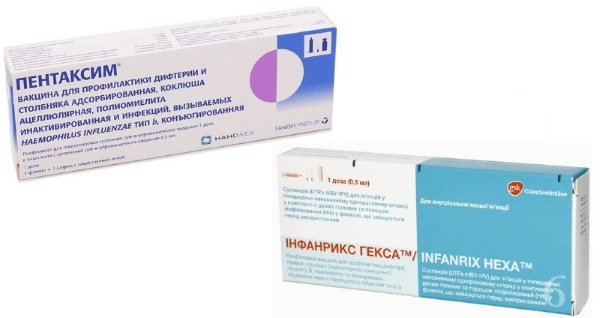
| Pentaxim | Infanrix Hexa |
| The main form of release of this drug is lyophilisate, on the basis of which a suspension is prepared. | To prepare an injection solution of this medication, it is necessary to dissolve the dry vaccine powder. |
| Pentaxim allows children to be immunized only against whooping cough, Haemophilus influenzae, diphtheria, polio, and tetanus. | The drug Infanrix Hexa stimulates the production of an immune response against the infectious pathogens of whooping cough, Haemophilus influenzae disease, diphtheria, polio, tetanus, and hepatitis B. |
| The cost of 1 injection of Pentaxim in a dosage of 0.5 ml is 1390 rubles. | The price of 1 dose of the Infanrix Hexa vaccine with a capacity of 0.5 ml is 1950 rubles. |
Infanrix Hexa and Pentaxim are multicomponent vaccines that are created specifically to protect the child’s body from most severe infectious diseases.
These drugs allow children to develop stable immunity, which lasts for most of their lives. Repeated revaccination is carried out only in cases of extreme necessity and in accordance with the national vaccination schedule.
The attending pediatrician, general practitioner or infectious diseases specialist at the district clinic is responsible for timely vaccination of the population. Carrying out a comparative description of these vaccines, we can come to the conclusion that Infanrix Hexa is a more effective drug.
